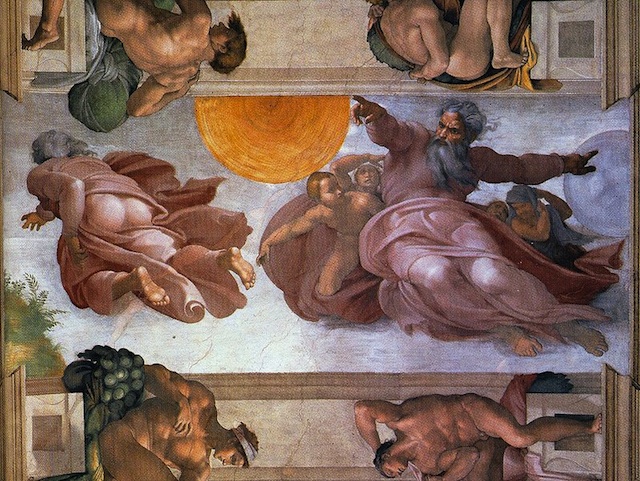
I did a little research afterwards and it turns out that's not quite right. That dude is God, and He's mooning us. (You can tell because he's wearing (or not) the same pink robes and has the same grey hair that He has in all the other panels.) The best part: the title of the panel is -- and I am not making this up -- The Creation of the Sun and the Moon.
Michelangelo must have had a sense of humor.
Unless that's the source of the phrase "mooning". One way to tell is figure out if "mooning" literally translates into other European languages.
ReplyDeleteWell, I'm pretty sure that the "creation of the moon" thing is just a coincidence. I have no idea if mooning was a common custom in renaissance Italy, and, if it was, if it was called "mooning" (or whatever the Italian equivalent is). But there is no doubt that Michelangelo painted God with dropped trou (or dropped robe as the case may be). I find that remarkable.
ReplyDeleteThat's an interesting scene. God creates the moon and sun, then turns away to do something else. Oddly the action seems to play out from right to left. I am surprised to see his butt and can't figure out why Michelangelo exposed it. You'd think that wouldn't be cool with the church, even with a dainty mesial groove.
ReplyDeleteFamously God created light before the sun, moon, and other celestial bodies.
There is nothing at all strange about the reality of light existing independent of the heavenly bodies. It is a well-established fact, illustrated in multiple ways, that “light” certainly is not restricted to the sun and the other luminaries of our universe. Just consider that phenomenon known as “lightning,” or ask the friendly “firefly” about the matter.
I kid, I kid. I wonder how "light" is different from light...
I had always wondered that, too, but just recently learned from the interwebs that it relates to Jerome's Latin translation of the Bible.
ReplyDeleteRead section IV
http://www.math.umass.edu/~rsellis/images-vs-words-long.html